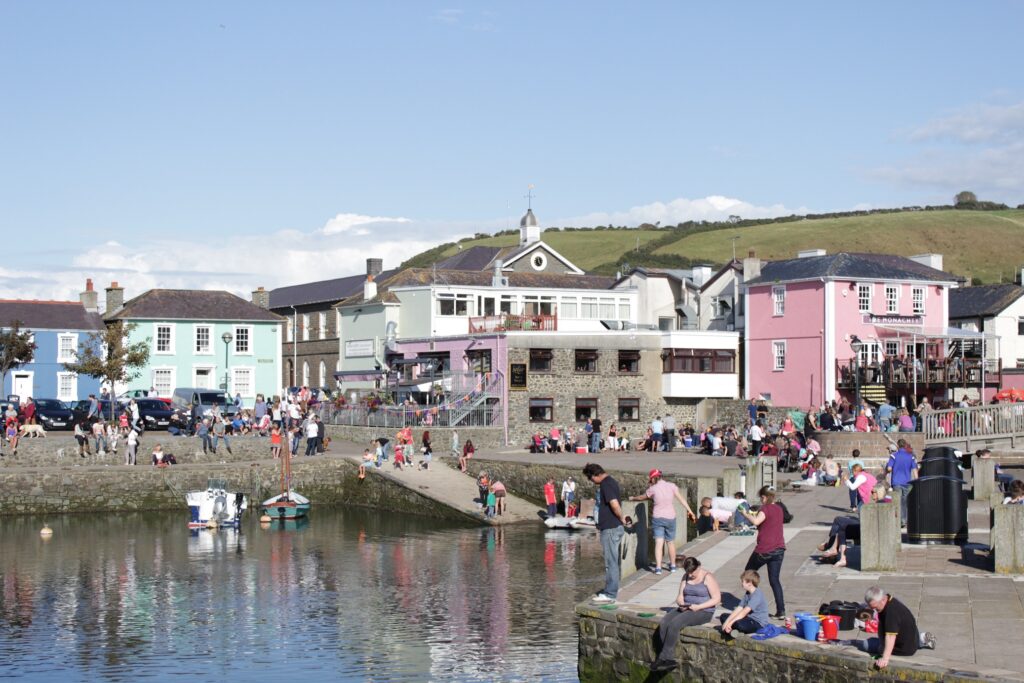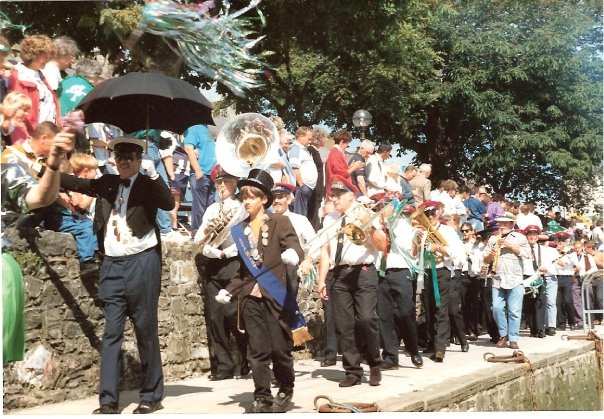Aberaeron

A PICTURE-POSTCARD pretty harbour town, Aberaeron was voted the ‘Best Place in Wales’ by the Royal Town Planning Institute in 2016. Situated between Aberystwyth and Cardigan, this ‘jewel of Cardigan Bay’ is home to the headquarters of Ceredigion County Council.
Once a busy fishing port, Aberaeron today, with a population of around 1,500, is one of Ceredigion’s best loved seaside holiday resorts with fashionable places to stay and eat.
Aberaeron also has a good selection of independent shops selling crafts, clothes, and great local produce, from the freshest of fish to cheeses straight from the dairy.
The Cardigan Bay Seafood Festival is held in July on the quayside. It’s an unmissable opportunity to taste local seafood and other local produce prepared by local and celebrity chefs.
For locals and regular visitors, a stroll along the quayside, at any time of the year, is not complete without a portion of pysgod a sglodion (fish and chips) and some delicious honey ice cream from The Hive.
The graceful lines of Regency architecture of the houses and commercial buildings along the harbour are a distinctive feature, grouped around a principal square. This is Alban Square, where a number of the town’s main events are held each year.
August is a great month for events in the town with the annual carnival, including jazz music and a colourful procession of floats from the Quay to Alban Square over the Bank Holiday weekend, a rugby sevens tournament and the annual Welsh Pony and Cob Festival on Square Field.

A life-sized statue of a Welsh cob stallion was donated to the town in 2005 by the Festival to denote the area as Welsh Cob country. It was created by sculptor David Mayer.
Aberaeron has two beaches – North and South, although the shoreline generally consists of steep storm beaches of pebbles, where sand is only visible at low tide.
The Ceredigion section of the Wales Coast Path runs along North beach, leading on to the harbour and, just a short walk though town, you’ll find Aberaeron’s Seaside Award and Green Coast Award winning beach, rewarded for amongst other things, its cleanliness. Aberaeron South beach was awarded the Blue Flag rural beach award in 2005. It contains the Harbourmaster Hotel.
Sailing plays a major part in the life of the town and the colourful harbour is awash with boats in summer. A series of regattas are organised by the Aberaeron Yacht Club each summer, as is the town’s beer festival, and it’s not many towns that can boast a tug-of-war competition across the harbour mouth, with the losers inevitably being pulled into the water.
The town and harbour were developed in the early 1800s by a local entrepreur, the Reverend Alban Jones-Gwynne, who obtained an Act of Parliament to develop one of the first ‘planned’ towns in Wales.
The harbour he built operated as a port and supported a shipbuilding industry in the 19th Century. A group of workmen’s houses and a school were built on the harbour’s north side, but these were reclaimed by the sea.
Many of the houses surrounding the harbour were owned by local sea-captains and many are named after far-flung destinations, such as Gambia and Melbourne.
Steam ships continued to visit the harbour until the 1920s but, in later years, it evolved into a small half-tide harbour for recreational craft.

Crafts were an important part of village life. Information recorded in trade directories shows that in 1830, although it was not yet fully developed as a port, there were in Aberaeron one woollen manufacturer, one bootmaker, one baker, one corn miller, one blacksmith, one blacksmith and shovel maker, two shipwrights, one carpenter and one hat maker.
In the late 1890s, a hand-powered cable car, the Aeron Express, was built to ferry workers across the harbour when the bridge was demolished by floods. The structure was recreated in 1988 as a tourist attraction that ran until the end of summer 1994, when it was closed under health and safety regulations.
Writing in The Guardian in 2016, Tom Dyckhoff exclaimed: “Let’s move to Aberaeron, Ceredigion – “it’s dolled up like an ad for Dulux… a pretty former fishing town where every house is painted a jaunty hue”.
The distinctive colours and render pattern on the houses were, in fact, featured on a postage stamp series celebrating British rural architecture.
Castell Cadwgan, a 12th Century ringwork fortification around a probable wooden structure, was located by the shore at Aberaeron, but has long since been claimed by the sea. Few traces remain today apart from some mounds of earth, the remains of the enclosure bank, most of the site having been eroded.

A short walk or cycle ride along the river Aeron takes you to Llanerchaeron, a minor gentry estate, now owned by the National Trust. The villa there, designed in the 1790s, is the most complete example of the early work of John Nash, the architect of London’s Regent Street and Regent’s Park.
Aberaeron’s Tourist Information Centre is located at the far end of the harbour and is open throughout the year and on Sundays during busy summer months and holiday weekends.
Aberaeron and the surrounding area has a great choice of places to stay. You can stay in a classical Regency villa typical of Aberaeron, a coaching inn or a country cottage.
The site of the local woollen mill still stands on the banks of the river Aeron and the famous Aberaeron shovel was produced in the local ironworks. Seafarers, farmers and townspeople alike had many a hostelry to choose from as, at its height, Aberaeron boasted some 35 public houses. Today only nine remain.
Dylan Thomas’s links with Aberaeron, New Quay and Talsarn have been documented by local author David N Thomas. The Dylan Thomas Trail runs through Ceredigion, passing through Aberaeron and ending in New Quay.
The railway service from the former Aberayron railway station (the terminus of the Lampeter, Aberayron and New Quay Light Railway, a branch of the Carmarthen to Aberystwyth Line) was closed to passengers in 1951 and to freight in 1965.
Notable people from the area include the photographer Ron Davies, opera singer
Sir Geraint Evans, who had a home in Aberaeron for more than 30 years, and BBC Radio Wales presenter Eleri Siôn.
